Marine News' Top Vessels of 2022
The November edition of Marine News magazine highlighted the most notable newbuilds delivered in 2022. From sturdy and nimble workboats, to the first new Jones Act laker in a generation, each vessel on display showcases the industry’s engineering prowess and technological ingenuity, with the focus on improving efficiency in operations. The maritime industry has no shortage of challenges to overcome, and each of Marine News’ top vessels will, in one way or another, aid efforts to tackle them.
Mark W. Barker
Owner: The Interlake Steamship Company
Builder: Fincantieri Bay Shipbuilding
Designer: Bay Engineering, Interlake Maritime Services
The Interlake Steamship Company’s newest vessel, the Mark W. Barker, ranks high among most noteworthy vessels built in North America in recent years. The first U.S.-flagged freighter built on the Great Lakes in nearly four decades, it is a modern, versatile addition to the otherwise aging fleet currently serving the region’s vital Jones Act trade.
“This is truly a historic celebration for our company and for the United States maritime industry as we proudly christen the newest vessel to join the U.S. flag fleet on the Great Lakes and our first new build in 41 years,” said Mark W. Barker, president of The Interlake Steamship Company and the vessel’s namesake, during a September christening ceremony held for the vessel in Cleveland. “While this ship may bear my name, it is a testament to the innovation, skill and grit of our employees who have powered our industry and propelled our company for more than 130 years.”
Believed to be the first newbuild for U.S. Great Lakes service built on the Great Lakes since 1983, the new River-Class, self-unloading bulk carrier is as “Great Lakes” as it gets—conceived, designed and constructed locally—using local materials. Built at Fincantieri Bay Shipbuilding in Sturgeon Bay, Wis., the 639-foot vessel was made from iron ore mined in Minnesota by Cleveland-Cliffs, and carried on U.S.-built, U.S.-crewed, and U.S.-owned Lakers to Cleveland-Cliffs’ Burns Harbor mill in Indiana. There the pellets were forged into steel plates and shipped to the Wisconsin shipyard.
“This American-made vessel is not only a veritable Great Lakes success story, it is a Cleveland ship, through and through,” said The Interlake Steamship Company’s chairman, James R. Barker. “Designed to navigate the winding curves of the Cuyahoga River, built with Cleveland-Cliffs steel and coated with Sherwin-Williams paint, the M/V Mark W. Barker was most significantly built as part of a long-term partnership to move Lake Erie-mined salt for Cargill Inc.”
The Jones Act qualified vessel, measuring 639 feet in length, 78 feet in beam, 45 feet in molded depth and 28,000 dead weight tons, will transport raw materials traditionally carried by lakers such as salt, iron ore and stone to support manufacturing throughout the Great Lakes region. And it has also been thoughtfully designed in preparation for the new cargoes of the future.
“If you toured the ship, you may have noticed in many respects that it is very different than a traditional Great lakes self-unloader. This is intentional as we made unique changes to the design of the ship so that it could be more versatile and more capable in meeting our customers’ needs,” Mark Barker said. “For example, the ship has large load-bearing MacGregor hatches that will allow project cargo to be loaded and carried on top of them.”
While five large hydraulically controlled stackable MacGregor hatches will allow the ship to transport specialty cargoes such as steel coils and windmill towers and blades, the vessel’s large hatches and cargo holds add even more capability. This ship will carry an average of 25,000 tons per trip, which is equal to the carrying capacity of 250 train cars, and 1,000 trucks. “The hatch openings are much larger than you’d see in a typical self-unloader. The hatches create a 46- by 80-foot opening into rectangular cargo holds below. This rectangular cargo hold will allow the vessel to carry close to 40% more cargo than a current vessel in the same trade. This box-shaped cargo hold will also allow to be able to utilize the ship to carry cargoes that may have not traditionally moved on the Great Lakes,” Mark Barker said. “It is important that we have the ability to move new types of cargo to meet the needs of the changing supply chain of the future.”
For added flexibility during cargo operations in congested ports, the unloading boom is located on the forward end of the ship, which many Great Lakes customers find more advantageous to allow placement in preferred areas for access at their docks, The Interlake Steamship Company said.
“This new vessel not only brings with it additional cargo carrying capacity and capabilities, it is the most versatile in our fleet and strategically sized to navigate into nearly any port on the Great Lakes,” said Brendan P. O’Connor, Vice President of Marketing and Marine Traffic. “The M/V Mark W. Barker will give us unmatched ability for cargo operations and to carry unique project cargoes because of her square-shaped cargo holds, her larger hatch openings, reinforced cargo hatches which can support deck cargo, and a forward mounted unloading boom. She truly was designed to be a vessel for the future.”
Among other notable features, the Mark W. Barker is the first ship on the Great Lakes with engines that meet EPA Tier 4 standards; its two 4,000-horsepower (hp) EMD engines use selective catalytic reduction (SCR) system to meet the strict emissions rules. The main engines turn a single four-blade, controllable-pitch Kongsberg Kamewa propeller through a Lufkin twin-input, single-output gearbox. The is also equipped with 1,000 hp Kongsberg bow and stern thrusters. The ship is reported to have a top speed in excess of 15 knots, though it can cruise somewhere around 13.5. For added efficiency, the ship’s hull has been optimized and all systems have been designed to ensure low energy consumption, while a Kongsberg high-lift rudder optimizes the wake through the propeller.
For its electrical power requirements, the vessel is provided with one Caterpillar 940-kilowatt (kW) ship service diesel generator, two 2,500 kW shaft generators and one Caterpillar 274 kW emergency generator.
Certainly, building a vessel that’s the first of its kind in several generations brings a unique set of challenges, but doing so during a pandemic creates a whole new level of difficult. “Construction was not without its challenges,” Mark Barker said. “This ship was built in the midst of a global pandemic during which the country was experiencing government-mandated shutdowns, supply chain disruptions, labor shortages and challenges not previously seen in our lifetimes. However, despite all those challenges, the project moved forward, and the work got done. We took delivery of this beautiful vessel this past July.”
The vessel promptly entered service after delivery, taking a brief break for its official christening in September. The ceremony was a who’s who event bringing together some of the biggest names in the U.S. maritime industry—a testament to a venerable Great Lakes shipping company ands groundbreaking new vessel.
| Key Milestones for the MV Mark W. Barker |
|---|
| 2015 – Cargill came to The Interlake Steamship Company with the idea for the vessel 2017 – The Interlake Steamship company began creating the vessel design in house May 2019 – The Interlake Steamship Company signed a construction contract with Fincantieri Bay Shipbuilding after working with the shipyard and Bay Engineering to finalize the design August 2019 – First steel cut at Fincantieri Bay Shipbuilding June 2020 – Keel laying ceremony held at Fincantieri Bay Shipbuilding where it was revealed the vessel would be named after The Interlake Steamship Company’s second-generation leader, Mark W. Barker October 2021 – Mark W. Barker was floated out at Finantieri Bay Shipbuilding July 2022 – Fincantieri Bay Shipbuilding delivered the Mark. W Barker to The Interlake Steamship Company, and the vessel promptly entered operations September 2022 – A christening ceremony was held in Cleveland |
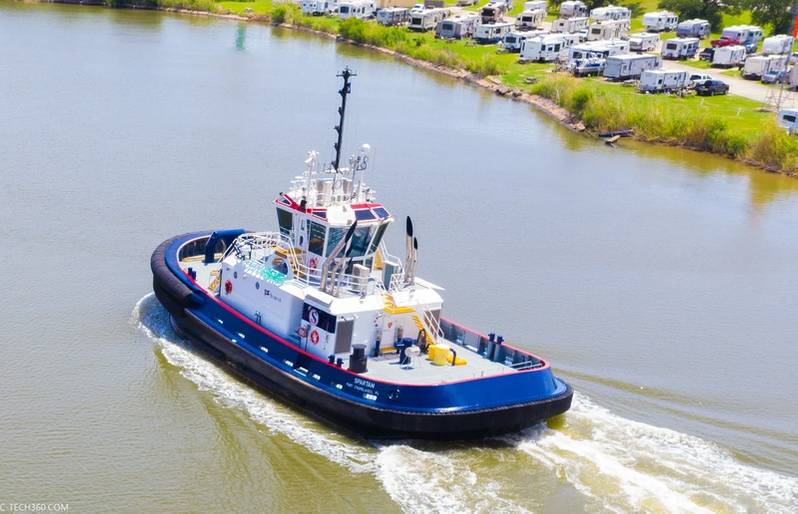 Spartan (Photo: Seabulk)
Spartan (Photo: Seabulk)
Spartan
Owner: Seabulk
Builder: Master Boat Builders
Designer: Robert Allan, Ltd.
This March, Fort Lauderdale, Fla.-based Seabulk put into service its first ever electric-hybrid tugboat, Spartan, built by Master Boat Builders in Coden, Ala.
Seabulk has already seen good results from Spartan as the tug continues working in Port Arthur, Texas. The electric-hybrid vessel serves as a stepping stone toward the ultimate goal of minimizing carbon emissions. Seabulk’s parent company SEACOR is a member of the Global Maritime Forum’s Getting to Zero Coalition, which aims to decarbonize the shipping sector through zero carbon technologies and sustainable alternative fuels. “One day we’re going to get there; and this hybrid propulsion system on Spartan allows us to evaluate the technologies including electric motors as a foundation for the propulsion system,” explained Russ Jones, Director of Technical Services at Seabulk.
“We evaluated the different power requirements for the vessel, to ensure safe and efficient solutions for our customers in the different ports that we operate in,” Jones said. “For Spartan working in Port Arthur, Texas is subject to long transits to and from port facilities. We saw this operating profile as ideal to capitalize on hybrid technology for those long transits.”
The Robert Allan Ltd.-designed RApport 3000 vessel is 98 feet long with a beam of 43 feet and draft of 18.5 feet. Spartan is built to meet U.S. Coast Guard regulations and is classed through the American Bureau of Shipping (ABS), with escort notation.
Notably, the tug features a fully integrated hybrid propulsion plant from Berg Propulsion, supplied by Thompson Caterpillar, a key partner throughout the build project, according to both the vessel’s owner and its builder.
“They were huge partners of this, and we couldn’t have done it without them,” said Garrett Rice, president at Master Boat Builders. “It’s one thing to have an electrical integrator or a dealer or partner come in and do the jobs. It’s another thing to have somebody really go above and beyond and take ownership of the process, really work with us in the way that we work. We’ve been doing business with Thompson for 35 years, and they are in our yard almost every day. And so having that synergy and understand the way we do business is really nice, and they did a really good job of working with us.”
The Spartan’s hybrid propulsion system utilizes two ABB 560KW electric motors combined with the two Caterpillar 3512E EPA Tier 4 main engines to power the Berg MTA628 Azimuth thrusters. The electrical power for the AC motors comes from a pair of 565 KW C-18 and a 200 KW C-7.1 Caterpillar generators sets, providing and respectively. In addition to its VS3 variable frequency drives with motors, and its own hybrid control system, Berg’s design, supply and integration includes the switchboard with full power management plus control of the Caterpillar main engines and gensets. Total installed horsepower is 6,881. Fuel filtration is provided by an Off-line C.C. JENSEN system.
“We went into this project not expecting to see a significant fuel reduction from the hybrid technology that’s utilized on the Spartan. It takes a certain amount of horsepower to propel the vessel through the water at required transit speeds, and whether you do that with auxiliary generator engines or main engines, the fuel savings is really negligent,” Jones said. “What really pushed us to make the decision to go with Hybrid is the opportunity to test bed the electrical propulsion systems and various battery solutions. We believe battery integrated hybrid tugs will deliver emissions benefits in the future.”
There is also important operational savings on top of the environmental benefits associated with the vessel’s hybrid system and EPA Tier 4 main engines. “In eco mode the vessel can transit to and from tug assist jobs without using the main engines. This saves service hours on main engines, roughly 1,500 hours annually. Over the course of vessel’s service life, this equates to a large savings when considering maintenance requirements,” Jones said.
While Spartan is not fitted with batteries as part of its hybrid propulsion system, dedicated space and provisions within the switchboard have been provided to allow for this in the future in case Seabulk ever decides to go that route.
Master Boat Builders’ Rice said he sees hybrid tugs as the way of the future, at least for the short- to medium-term, and that the shipyard—which has been involved in both hybrid and full-electric tug builds, including Crowley’s eWolf—has been positioning itself for a leading role as the industry evolves. “We want to be known as the best go-to tug builder in the U.S.,” Rice said. “The future of tugs is hybrid battery powered tugs over the next five to 10 years. And I think we’re in a good spot for that.”
From an operational standpoint, some of the Spartan crew members were initially hesitant about the new hybrid technology on board, Jones said. “That was all set aside when they got a chance to operate the vessel and witness its great performance firsthand,” he added. “The electric motors coupled to the drives really enhance performance and give instant control.” The vessel is capable of speeds around 12.6 knots. In power mode, Spartan’s main engines and electric motors/generators combine to provide a maximum bollard pull of 88.5 tons,” Jones said. Towing equipment includes hydraulic powered JonRie double drum winches, providing redundancy for towing operation with a complete second tow line at the ready.
Jones cited among other key features enjoyed by crew the vessels’ Alphatron/JRC supplied Alphabridge console arrangement, which provides an ergonomic control platform in the pilot house that integrates all the electronics, navigation and communication systems into the central control. “The operators on board value these features and comment on the reduced fatigue. This has been our standard for new buildings since 2017.”
In addition, the pilot house has large windows and bi-level layout, providing the operator with excellent visibility to working decks and a work space for the crew’s administrative tasks. Below deck are berths for eight, with four staterooms and four heads.
The vessel features all LED lighting throughout. And its main decks are coated with International Paint’s Intershield lightweight epoxy non-skid product for improved safety in working areas. Spartan has on board a pair of Viking 10-person life rafts.
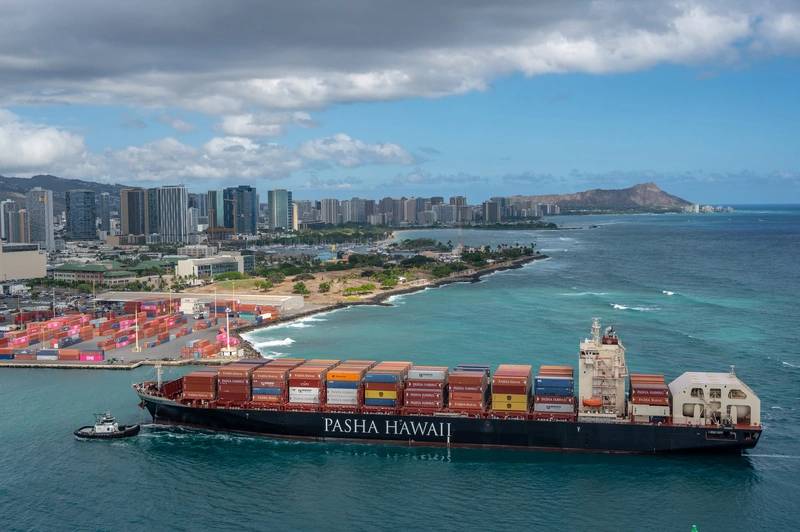 George III (Photo: Nick Souza)
George III (Photo: Nick Souza)
George III
Owner: The Pasha Group
Builder: Keppel AmFELS
Designer: Keppel AmFELS
Hawaii-based The Pasha Group this summer welcomed the newest addition to its containership fleet with the arrival of George III, the first liquefied natural gas (LNG) powered vessel to serve Hawaii.
The 774-foot, 2,525 TEU containership was built in Brownsville, Texas by Keppel AmFELS as the first of two new ‘Ohana class vessels built to service the Hawaii-U.S. mainland trade for operator Pasha Hawaii, a wholly owned subsidiary of the family-owned The Pasha Group, one of the nation’s leading Jones Act shipping and integrated logistics companies.
Prior to commencing its maiden voyage to homeport Honolulu this summer, George III became the first LNG vessel to fuel on the U.S. West Coast when it bunkered at the Port of Long Beach in California.
As the most technologically advanced and environmentally friendly vessel to serve Hawaii, the new Jones Act vessel surpasses the International Maritime Organization (IMO) 2030 emission standards for ocean vessels. LNG-powered ships achieve a 99.9% reduction in diesel particulate matter and sulfur oxide emissions, 90% less nitrogen oxides and a 25% reduction in carbon dioxide compared to ships running on traditional fuels. And while George II has been operating on LNG fuel from day one, the vessel’s dual-fuel 30,000-kW MAN B&W 7S80 ME-GI slow speed, two stroke, direct drive engine is also able to burn VLSFO and/or ULSFO. The ship is capable of sailing speeds around 23 knots.
Auxiliary engines include three MAN B&W 6L35/44 dual-fueled generating sets. George III is equipped with two 1,200 cubic meter LNG C-type cylindrical tanks with episoidal head ends located on deck at the aft of the vessel. Its engine room is equipped with Kongsberg integrated control and monitoring system, and the vessel also features a Cavotec Alternative Maritime Power (AMP) system for connecting to shore power in port. Further energy efficiencies are achieved by the ship’s optimized hull form as well as its high-efficiency rudder and 28’ MAN fixed-pitch five-bladed propeller. The vessel is also equipped with an Alfa Laval Pure Ballast 3 ballast water management system.
“We celebrate three generations of service to the people of Hawaii with the arrival of the MV George III to Long Beach,” said George Pasha, IV, President and CEO, Pasha Hawaii. Named after Pasha, IV’s late father, the vessel was designed to represent the innovative and entrepreneurial spirit of George Pasha, III. “Shortly after my father joined my grandfather in the family business, he quickly laid the foundation for growth and success,” added Pasha, IV. “Through my father’s leadership, what started out as a personal vehicle storage company, evolved into a world-class global logistics and transportation company. As we mark our 75th anniversary and welcome George III to Long Beach, we are proud to continue my family’s legacy of innovation and environmental stewardship, while recognizing our employees as our extended ‘ohana.”
George III will soon be followed by Pasha’s second ‘Ohana class LNG containership, the Janet Marie, expected for delivery from Keppel AmFELS in the fourth quarter of 2022.
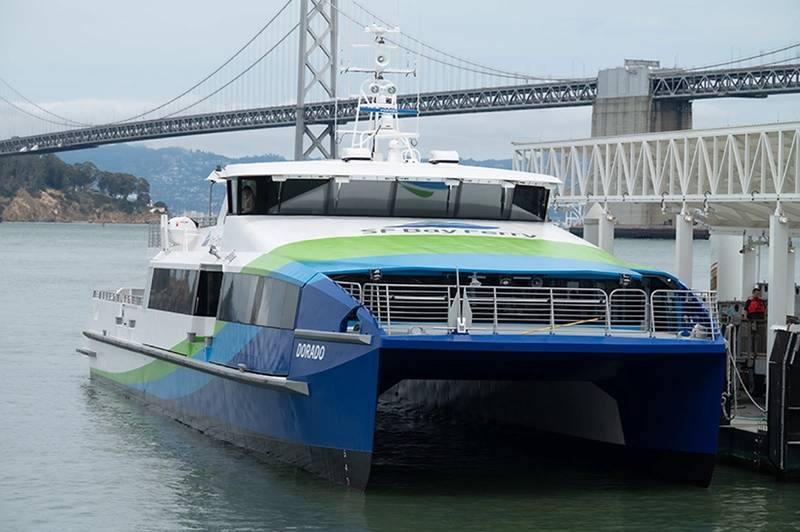 Dorado (Photo: WETA)
Dorado (Photo: WETA)
Dorado
Owner: WETA
Builder: Mavrik Marine
Designer: One2Three Naval Architects
A new high-speed passenger vessel that entered service for the San Francisco Bay Area Water Emergency Transportation Authority (WETA) this year is the agency’s fastest and most agile.
WETA is a regional public transit agency tasked with operating and expanding ferry service on the San Francisco Bay, and its new 130-foot-long aluminum catamaran Dorado is the first in a series of four newbuilds ordered from La Conner, Wash. shipyard Mavrik Marine. The U.S. Coast Guard-certified Subchapter K ferry was designed by Australia-based One2Three Naval Architects, and construction management services were provided by San Diego-based Aurora Marine Design.
“WETA is building a world class ferry system for the Bay Area and adding new vessels like MV Dorado helps us get there,” said Jim Wunderman, chair of the WETA board of directors. “This American-made ferry enhances the capacity of our fleet and provides additional flexibility for our operations, helping ensure we run the system as efficiently as possible. It also happens to be a beautiful ferry.”
Vessel construction was funded through the Federal Transit Administration and the State of California’s Proposition 1B in collaboration with the California Office of Emergency Services. Construction on the second vessel in the Dorado class, Delphinus, is underway.
Dorado has capacity for 320 passengers with indoor and outdoor seating across two decks, while expansive outdoor passenger space allows more riders to experience a fresh-air trip across the Bay. It also has room on board for three dozen bicycles.
While Dorado is the fastest vessel in WETA’s current fleet with a service speed of 36 knots, it is also the most flexible, as the first boat built for WETA that can safely dock at any of the system’s 12 ferry terminals. It initially entered service rotating among WETA’s routes to collect operational data and allow passengers across the ferry system to experience the boat, the agency said.
WETA claims San Francisco Bay Ferry was the fastest growing transit operator in the region prior to the pandemic, with more than 3 million passengers in 2019. Between 2012 and 2019, ridership on the system doubled.
Today, under WETA’s Pandemic Recovery Program, which took effect in July 2021, ferry ridership is steadily growing. The program decreased fares 30% across the system and adjusted service to provide more flexibility for riders. WETA also launched a new integrated ticketing system and smartphone app for San Francisco Bay Ferry to improve and streamline the fare payment system. By June 2022, ridership on San Francisco Bay Ferry vessels reached 63% of pre-pandemic levels, outpacing comparable regional agencies, according to WETA.
Dorado is fitted with twin MTU 12V 4000 M65L diesel engines, producing 2,575 horsepower at 1,800 rpm each, and paired with HamiltonJet HT810 waterjets through ZF 7600 reduction gears. HamiltonJet also supplies its AVX package, which includes steering and controls.
Dorado is the ninth U.S. Environmental Protection Agency (EPA) Tier 4 or Tier 4 equivalent passenger ferry in WETA’s fleet. In 2017, WETA commissioned the nation’s first Tier 4 equivalent high-speed passenger ferry, Hydrus. In 2019, WETA commissioned the nation’s first Tier 4 certified high-speed passenger ferry, Pyxis. Earlier this year, WETA re-entered Pisces into service after a conversion project replacing the vessel’s Tier 2 engines with cleaner Tier 4 engines.
Dorado and its three sister vessels are expected to be WETA’s final new ferries equipped with diesel propulsion, as the agency expects to order only zero-emission passenger ferries going forward. In fact, it expects to begin work on its first two zero-emission vessels before year end.
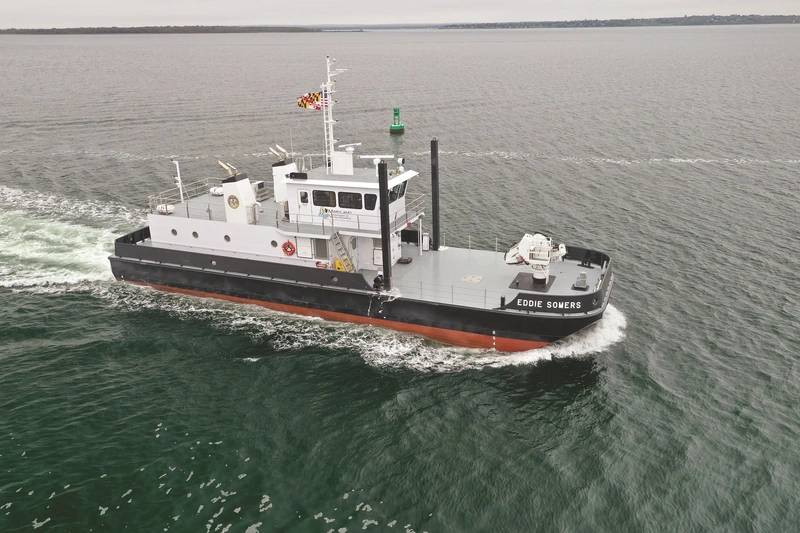 Eddie Somers (Photo: Blount Boats)
Eddie Somers (Photo: Blount Boats)
Eddie Somers
Owner: Maryland Dept.
of Natural Resources
Builder: Blount Boats
Designer: BMT Designers & Planners
Warren, R.I. shipbuilder Blount Boats this year delivered a new buoy tender/icebreaker built for the Maryland Department of Natural Resources (DNR). Eddie Somers was handed over on May 19 at Somers Cove Marina in Crisfield, Md.
The 94- by 227-foot shallow draft vessel is named after former DNR Capt. Eddie Somers, who retired in 2018 after 25 years as captain of the long-serving boat the new vessel is replacing, the J. Milliard Tawes, which has been in service for nearly 50 years.
The retiring vessel was built for the U.S. Coast Guard in 1941, and operated as a buoy tender until the early 1970s, when it was surplused by the federal government. The department acquired it for use on the Chesapeake Bay.
But unlike the retrofitted Tawes, the M/V Somers has been designed and purpose-built by DNR for the services it will provide, with a hull and running gear fortified for ice operations. Designed by BMT Designers and Planners, the Eddie Somers is powered by Cummins QSK19, Tier III marine engines, each producing 750HP at 1,800RPM, Twin Disc MGX-5202SC gearboxes and two 42x27 five-blade Michigan Wheel nibral propellers. A pair of Cummins Onan gensets produce 55 kW of electrical power each for service power. The steering system is a Jastrom B2-76-400-1-35 and the controls are Twin Disc EC300s. In addition, the vessel is equipped with a Melcal 5-ton knuckle boom crane for buoy and debris removal applications.
The boat built to ABS standards and is U.S. Coast Guard Subchapter T certified. It will serve as the primary icebreaking asset for Crisfield Harbor and Smith Island, in addition to placing buoys and performing other functions. As was the M/V Tawes, the M/V Somers will also be a lifeline to Smith Island when the waters surrounding it freeze over, with the boat clearing a path for supply and shuttle boats. By cooperative agreement with Virginia through the U.S. Coast Guard, the M/V Somers will also provide this service to Tangier Island in Virginia when requested. During heavy ice seasons, all food, fuel, medicine, and emergency transport going to and from the islands are supplied by the vessel.
“This is a great example of our efforts to modernize the assets of the Maryland Department of Natural Resources while also honoring our department’s 50-year legacy of service,” said Secretary Jeannie Haddaway-Riccio. “It is also a DNR tradition to name vessels after employees with exemplary years of service, so it is very fitting that it will be named after Capt. Eddie Somers who has done so much for his community, Smith Island and the State of Maryland.”
The DNR’s Hydrographic Operations team, based on the Eastern Shore, operates four large boats that perform various duties throughout the Chesapeake Bay. The department’s boats are shallow draft, meaning they can get into rivers and shallow areas of the Bay.
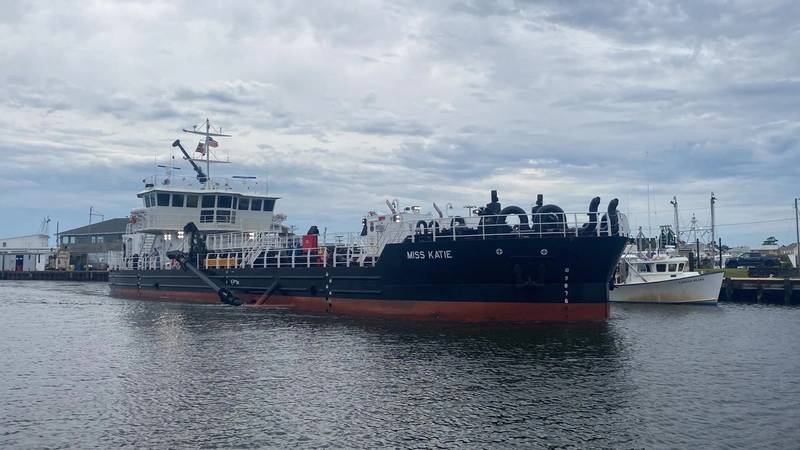 Miss Katie (Photo: Dare County)
Miss Katie (Photo: Dare County)
Miss Katie
Owner: EJE Dredging Service
Builder: Conrad Shipyard
Designer: Jensen Maritime
EJE Dredging Service, as part of a public/private partnership with Dare County, has recently taken delivery of a new shallow-draft hopper dredge on the Outer Banks of North Carolina. The newly built Miss Katie departed from Conrad Shipyard in in Morgan City, La. on August 13, and arrived at its new home port in Wanchese on August 19.
Local commercial and sport fishing industries, as well as the others that support them, are hoping that the new dredge will be an answer to the significant shoaling issues that have plagued various channels and inlets throughout Dare County. “There’s about 1.2 million cubic yards of sand that move across the inlet every year, and removal of it is paramount,” said Oregon Inlet Task Force Chairman and Dare County Commissioner Jim Tobin. “This really affects our recreational fishing and especially our commercial fishing business. We virtually have lost just about all of our commercial fishing fleet because of the shoaling issues.”
Tobin said an economic impact study revealed the value of an open inlet to be about $500 million a year, plus or minus, depending on the year, while a fully opened could be up to $1 billion per year, meaning investing to address the shoaling problem would deliver a big payback.
In May 2019, the Dare County Board of Commissioners unanimously approved a contract for the construction and operation of a new split-hull dredge that could be used mostly in maintaining Oregon Inlet, as well as in Hatteras Inlet and other state waterways. Funding for the project came from a public-private partnership with the state of North Carolina, in which the legislature allocated $15 million from the Shallow Draft Navigation Channel Dredging and Aquatic Weed Fund for the purchase of the dredge.
“With the arrival of the Miss Katie, we look forward to providing an open and navigable channel for the waterways in the region,” said Jordan Hennessy, vice president of EJE Dredging Service, the private partner that owns and operates the 156-foot-long dredge. “The Miss Katie has been specifically developed and designed to ensure she will be able to safely navigate the channels and inlets of North Carolina. The split-hull configuration will allow spoil discharge in shallow waters, thus preventing the vessel from grounding on her own hopper load.”
Designed by Jensen Maritime, the ABS-classed dredge will be able to operate up to 12 hours a day, weather permitting, providing strategic dredging in area waterways. Miss Katie’s operations will be managed by the Oregon Inlet Task Force, whose members will be responsible for scheduling, planning and monitoring the success of the dredging efforts that are undertaken.
“I can’t tell you how excited I am to stand here with Miss Katie behind me,” said Tobin. “Having access to this dredge and having a dredge here full time is going to be huge because we’re going to be able to be there right after a storm hits all the hotspots going in and out the channel and just constant maintenance, which it’s never had.”
Tobin highlighted the fact that the public-private partnership that was formed to develop the dredge is the first of its kind—and an endeavor that many people across the country have been closely watching unfold since day one. “We went out and did a public-private partnership—the first one in the United States,” said Tobin. “There are many, many other people watching what we did. Every time we’d go to one of these meetings—we just got back from a meeting in Wilmington—and people asked about this particular vessel and how we did it.”
“The completion of Miss Katie and her long-awaited arrival here on the Outer Banks is a historic moment and will be a game-changer for watermen in Dare County,” said Dare County Board of Commissioners Chairman Bob Woodard. “Commercial and recreational fishing are not just enormous economic drivers in our community; they’ve also been a way of life for thousands of folks here in Dare County for generations. It’s absolutely critical that we have the resources in place to properly dredge our channels and inlets that these watermen depend on as their highway to get to work every day—and thanks to the county’s partnership with EJE Dredging and the arrival of Miss Katie, we’ll be much better equipped to do just that.”
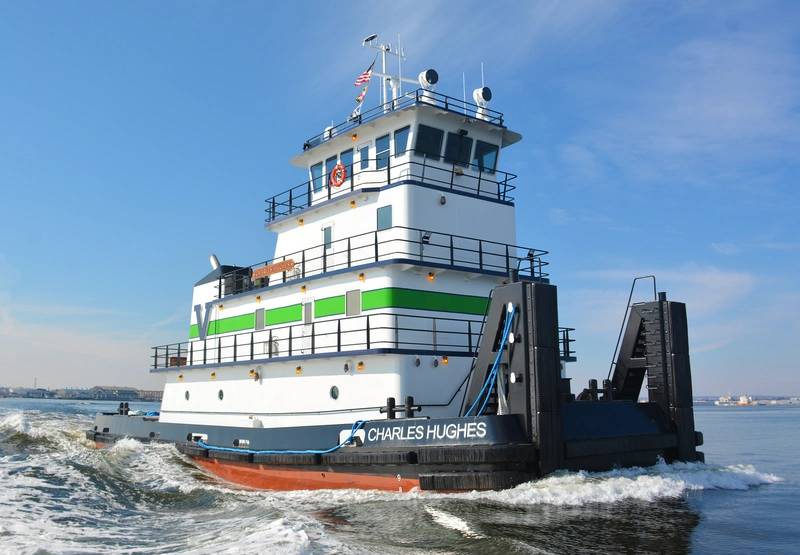 Charles Hughes (Photo: Vane Brothers)
Charles Hughes (Photo: Vane Brothers)
Charles Hughes
Owner: Vane Brothers
Builder: Chesapeake Shipbuilding
Designer: Chesapeake Shipbuilding
Baltimore-based Vane Brothers earlier this year welcomed the final boat in a series of four 3,000-horsepower Salisbury Class push tugs. Named the Charles Hughes, Vane’s newest addition has entered service in the Northeast United States as the 20th Maryland-built towing vessel to join Vane Brothers’ fleet since 2008.
Designed and constructed by Chesapeake Shipbuilding shipbuilders and naval architects of Salisbury, Md., Vane’s Salisbury Class push tugs have a molded depth of only 10.5 feet, making them well suited for working in confined, shallow-draft waterways.
Capable of running speeds around 10.5 knots, the new push tug is equipped with Caterpillar 3512 main engines, conventional shafts, rudders and flanking rudders. Each main engine produces 1,500 hp at 1,800 rpm and is connected to stainless steel Hung Shen troost-style five-blade propellers through Twin Disc MGX-5600 gears with 6:1 ratios. The vessel is also equipped with Fernstrum box coolers as well as 65-ton Patterson winches and JonRie InterTech capstans.
A roomy pilothouse features both Simrad and Furuno electronics, as well as dual Rose Point electronic charting systems. Down below, the vessel accommodates up to seven crewmembers in large private and semiprivate quarters.
The Charles Hughes’ three sister tugs, the Salisbury, Annapolis and Rock Hall, were delivered in 2019, 2020 and 2021, respectively. Along with providing exceptional crew comfort, reliability and operational efficiency, all four Salisbury Class push tugs comply with federally mandated, U.S Coast Guard-enforced Subchapter M safety standards.
According to Vane Brothers president C. Duff Hughes, “Vane Brothers takes pride in providing our customers and crews with vessels constructed to the highest standards. The Charles Hughes is another powerful, peak-performing tug that maximizes maneuverability where it is needed most.”
To create the Salisbury Class design, Chesapeake naval architect John Womack worked in collaboration with Vane Brothers port captain Jim Demske, who has overseen construction of 48 tugboats for Vane over the last two decades. “Chesapeake has such a talented group of shipbuilders right in our backyard,” Demske said. “Each tug capitalizes on safety, comfort and productivity.”
The tug Charles Hughes is named in honor of the late Charles F. Hughes, former Vane Brothers Chairman of the Board and the father of Vane’s current President, C. Duff Hughes. A previous push tug Charles Hughes, built in 1975 and rated at 1,800 horsepower, was acquired by Vane Brothers in 1991 and sold in 2019. The classic-looking nameboards from the first Charles Hughes were refinished and are now mounted on the new vessel.
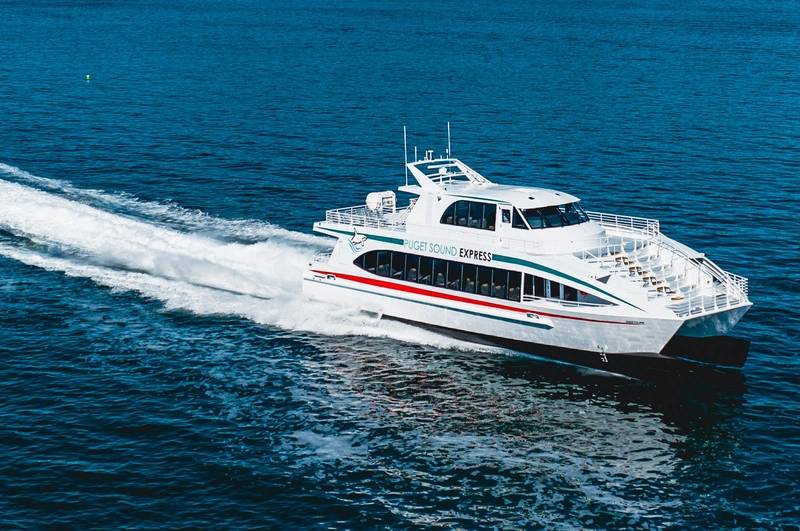 Swiftsure (Photo: All American Marine)
Swiftsure (Photo: All American Marine)
Swiftsure
Owner: Puget Sound Express
Builder: All American Marine
Designer: Teknicraft Design
Bellingham, Wash. shipbuilder All American Marine (AAM) this summer delivered the new whale-watching vessel Swiftsure to Puget Sound Express (PSE). Modeled after the AAM-built and Teknicraft-designed Saratoga delivered in the Spring of 2018, the new larger 77-foot Swiftsure maintains performance while adding space to PSE’s whale watch and eco-tourism business.
The vessel’s design offers passengers a smooth ride and comfort as the hull provides a cushioned effect when encountering waves, AAM said. The 150-passenger, semi-displacement catamaran hull for this vessel was developed by Nic de Waal of Teknicraft Design in Auckland, New Zealand. The design integrates the signature Teknicraft symmetrical and asymmetrical combined hull shape, bow wave piercer and a dynamic hydrofoil system. This advanced hull shape was custom-designed using digital modeling and computational fluid dynamics (CFD) analysis. The hull design is complemented by Teknicraft’s signature integration of a wave piercer positioned between the catamaran sponsons to break up wave action and ensures reduced drag while enhancing passenger comfort.
PSE co-owner Peter Hanke said, “The Swiftsure is the third boat that we have had the opportunity to build with All American Marine. Once again, this vessel has exceeded all performance expectations while incorporating EPA Tier 3 engines. Despite numerous supply chain challenges during the construction process, All American still delivered this exceptional vessel on time and on budget. They listened to us, and as they did on the first two vessels, met or exceeded our needs.”
The USCG Subchapter T certified high-speed catamaran has two asymmetrical semi-planing hulls, and an adjustable aluminum midship hydrofoil plus two aluminum aft foils, which allow the boat to achieve top speeds of 40+ knots. This design, coupled with finely tuned, wave-piercing eco bows, enables the boat to travel through both calm and rough water at full cruising speed, while keeping underwater noise to a minimum, AAM said.
The Swiftsure was designed from top to bottom for low fuel consumption at high speeds, a critical factor to the success of the daily whale watch tours originating out of Edmonds, Wash. The vessel also utilizes four Hamilton Jet HJ364 water jets, complete with the Hamilton Jet control system. “We’ve done many years of research to develop a vessel design that’s particularly low-wake, due in large part to our unique hydrofoil system that doesn’t displace as much water and create waves as is the case with traditional hull design,” said designer Nic de Waal.
The vessel is powered by four Scania Di 16 082M engines with a rating of 800 mhp at 2,300 RPMs. The soundproofing details in the engine room ensure that the passenger cabin is quiet and comfortable throughout the ride. The interior of the vessel is finished with cutting-edge materials, including recyclable Ayres aluminum honeycomb wall panels and recyclable Dampa aluminum ceiling tiles with acoustic insulation that span the main cabin as well as the interior cabin on the second deck. Other amenities include ADA-friendly accommodation spaces, comfortable Beurteaux seating, three restrooms, and an extended galley complete with a full-service bar for passengers. The Swiftsure is also equipped with seven HDTVs and a premium sound system with speakers inside and out for a fully immersive experience throughout the vessel’s journey.
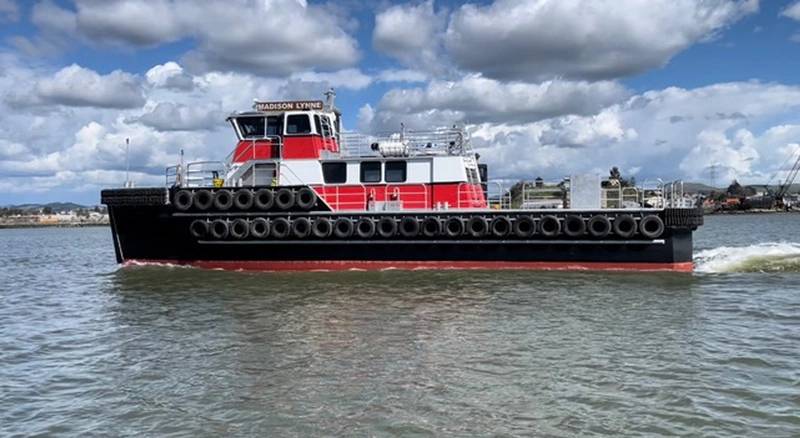 Madison Lynn (Photo: Moose Boats)
Madison Lynn (Photo: Moose Boats)
Madison Lynne
Owner: Westar Marine Services
Builder: Moose Boats
Designer: Incat Crowther
San Francisco-based Westar Marine Services this year put into service its first ever newbuild, the 75-foot crew and cargo transfer vessel Madison Lynne, from Vallejo, Calif. boatbuilder Moose Boats. The new vessel offers improved performance that ultimately allows Westar to expand its cargo and passenger carrying capabilities for its wide and varied customer base.
Founded in 1976, Westar is today a women-owned and -operated company offering marine construction services, escort and towing, barges, water taxis and stores deliveries to the San Francisco maritime community 24/7 from their home dock at Pier 50.
The company’s new Incat Crowther-designed aluminum catamaran will be used for passenger and cargo transfers in the San Francisco Bay. Operated by a crew of two or thee, it has carrying capacity of more than 15,000 pounds of cargo and a passenger capacity of 28. At 75 feet long, the vessel is the largest ever built by Moose Boats.
While Incat Crowther in Lafayette, La. provided naval architecture services for the final design and USCG Subchapter T compliance, Moose Boats designed the cabin superstructure and general arrangement in-house with collaborative input from Westar. Engine, steering and joystick maneuvering controls in both the raised pilothouse and the upper level aft steering station provide captains with optimal visibility for bow and stern operations.
A Volvo Penta IPS (Integrated Propulsion System) ensures improved fuel efficiency, speed and maneuverability compared to other vessels in Westar Marine Services’ fleet. Twin Volvo D13 turbo diesel engines with Volvo IPS3 drives provide efficient propulsion for the aluminum catamaran achieving a service speed of 25 knots and exceptional close quarters maneuverability.
“This build was a great collaborative effort between Westar, Incat Crowther, Helmut’s Marine, Volvo Penta and Moose Boats,” said Moose Boats’ general manager, Steve Dirkes. “To see a boat of this size walk sideways without any bow thrusters is pretty incredible and a testament to the Volvo Penta IPS drives.
“We appreciate Westar choosing us for this build and hope they are as happy with their new boat as we are to have built it.”
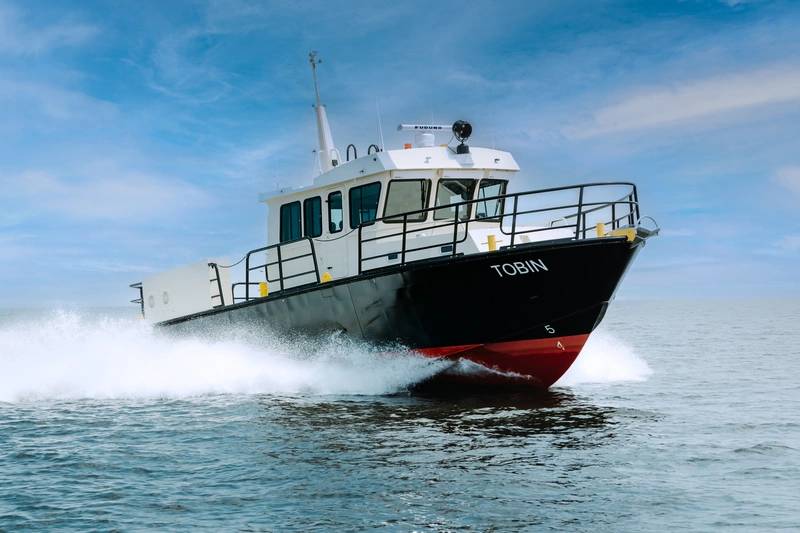 Tobin (Photo: Silver Ships)
Tobin (Photo: Silver Ships)
Tobin
Owner: U.S. Army Corps of Engineers
Builder: Silver Ships
Designer: Silver Ships
A new marine surveying vessel is custom designed for the U.S. Army Corps of Engineers (USACE) to hydrographically map the mouth of the Mississippi River, allowing researchers to accurately and effectively obtain and document data on the rapidly changing waters in the mighty river.
Delivered by Alabama shipbuilder Silver Ships to USACE’s Venice Sub Office in Venice, La. earlier this year, Tobin is equipped to handle challenging river terrain as it conducts condition surveys of the river to further the safety of marine operations by helping to keep waterways open and prevent obstructions to marine navigation. “Tobin [joins] a fleet of vessels operating out of the USACE Venice Sub Office that works year-round to provide river condition data to vessel operators,” said Jason Powers, Director of Business Development for Silver Ships. “This data is essential to the safe and efficient transportation of goods up and down the Mississippi River.”
The 49-foot Tobin is the latest expansion in Silver Ships’ Endeavor series of workboats and is the largest marine surveying vessel of its series. The vessel is powered by twin Caterpillar C18 Tier 3 engines making 800 hp each to reach speeds of 28 knots. The single Caterpillar C2.2 Tier 3 genset provides 25 ekW of electric power for Tobin’s air conditioning, echo sounder and other electrical needs onboard.
Richard Tremayne, Thompson’s Marine Business Manager, said, “Together our engineering teams have designed and built significant boats like Tobin over many years. High-performance power installations are always fun puzzles to solve with talented companies like the Silver Ships team.”
Tobin operates with MGX5136RV Twin Disc marine gears, Michigan Wheel propellers, Furuno navigation and communication systems, Delta ‘T’ Systems engine room ventilation, Arid Bilge Series 4 system and Ayres paneling. Additionally, Tobin is equipped with state-of-the-art technology including the Teledyne Marine EchoTrac E-20 survey system, which uses a single-beam transducer that charts river depths and monitors water changes that could be potentially hazardous to marine navigation.
This vessel’s name honors Thomas G. Tobin who worked for the USACE New Orleans District for more than 30 years. As a capable engineer and brilliant programmer, Tom developed systems that automated the processing and mapping of daily navigation condition surveys collected. He was a part of the Engineering Division Channel Improvement team and he achieved success with their automated design functions that ensure successful operations of the Mississippi River. Mr. Tobin passed away in February 2016, at the age of 54, after a battle with cancer. Mr. Tobin dedicated his skills to the Corps mission and made a broad, lasting and meaningful impact on the entire district and the citizens of south Louisiana.













